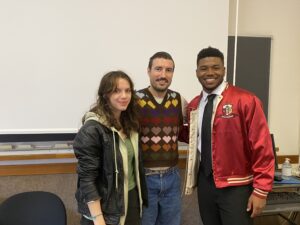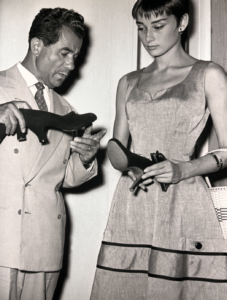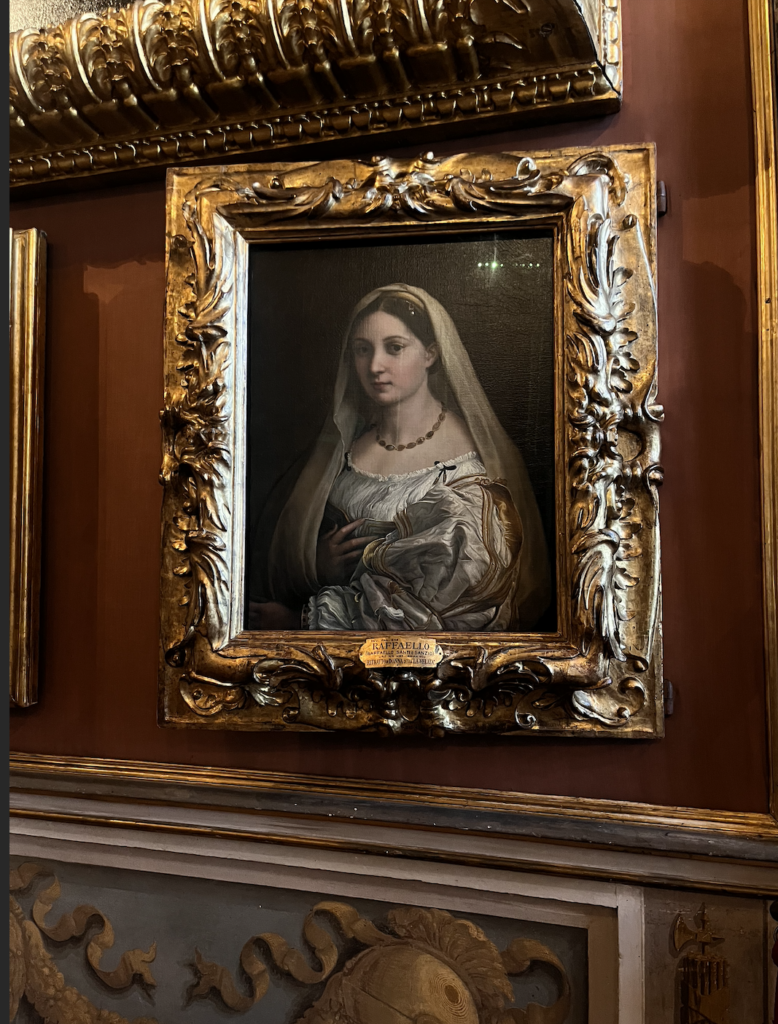A Mini Summary of the 2024 Mosaic Trip
By Bella Lapp
Over the course of the Fashioning the Body, Shaping the Nation mosaic research trip, our group visited Milan, Bologna, Ferrara, Florence, Prato, Perugia, and Rome. We interviewed various people from different points in the fashion supply chain – fashion designers, consumers, and workers who specialized in different aspects of garment construction and sales.
We began the trip in Milan, where we first visited Fondazione Sozzani, an exhibition space “dedicated to the promotion of culture through photography, fashion, the fine arts, and applied arts.” At the foundation, we heard a brief presentation on the foundation’s history and had the opportunity to interview Andrea Batilla (in the picture below with the Mosaic group), an expert fashion brand consultant who has worked with high-end brands like Trussardi and Bottega Veneta.

Also in Milan, we visited the Armani Silos, an unconventional museum/exhibition space dedicated to the Armani brand. Additionally, a small group visited Cooperative Alice (picture above), a cooperative dedicated to sustainable development that partners with local prisons to provide jobs in ethical garment production.
Next, in Bologna, the whole group attended an interview with Marco Rambaldi (in the picture below with Roma Cervino and Keon Eady, two Mosaic students) a young fashion designer who is one of the few current fashion designers in Italy not based in Milan.

We also had the opportunity to interview three fat activists who have dedicated themselves to fighting fatphobia and promoting fat acceptance in Italy. Two of the interviewees were on Zoom, Chiara Meloni and Mara Mibelli, founders of Belle Di Faccia, while Elisa Manici joined us in person. The group also visited a cooperative named Gomito a Gomito with a similar mission to Cooperative Alice, but a different structure. After this visit, we had the opportunity to interview a long-time employee of Gomito a Gomito named Agnes Schwienbacher. Our last interview in Bologna was with Desirée Madonna, the owner of a small shop located in center city named Eticlo. While in Bologna, the group took a day trip to Ferrara and visited the atelier of young designer Francesca Liberatore, who partially renovated a beautiful church to exhibit her clothes alongside her father’s art.
Our time in Florence began with a visit to the Pitti Palace, a museum inside a Rennaisance-era palace where the famous Medici family once lived. The museum had a costume gallery exhibit dedicated to the history of Italian fashion with original garments from the Medici family on display. Our first interview in Florence was with Debora Florio at the Bio Fashion Lab, where she discussed unethical consumption and fashion education. Additionally, the Bio Fashion Lab invited the group back to a panel event where we learned about the Triangle Shirtwaist Factory fire’s impact on  workers’ rights and heard from former employees of Prato’s garment industry who spoke about unethical working conditions. We also visited the Ferragamo museum (the picture of a poster with Salvatore Ferragamo with Audrey Hepburn was taken at the museum exhibit) in Florence dedicated to Salvatore Ferragamo’s long-standing high-end Italian fashion brand mostly dedicated to women’s shoe design. The Ferragamo museum left the whole group with a lot of questions, especially after seeing the exhibit dedicated to famous people who have worked with Ferragamo. The photo included is of Audrey Hepburn and Salvatore Ferragamo. After Ferragamo, we visited the Gucci Garden, another unconventional museum-like space dedicated to the history of image-making and marketing at Gucci. The Gucci museum felt more like a pop-up space for photos than a museum if you didn’t read the walls. I left knowing fairly little about the story of Gucci besides a few names of creative directors.
workers’ rights and heard from former employees of Prato’s garment industry who spoke about unethical working conditions. We also visited the Ferragamo museum (the picture of a poster with Salvatore Ferragamo with Audrey Hepburn was taken at the museum exhibit) in Florence dedicated to Salvatore Ferragamo’s long-standing high-end Italian fashion brand mostly dedicated to women’s shoe design. The Ferragamo museum left the whole group with a lot of questions, especially after seeing the exhibit dedicated to famous people who have worked with Ferragamo. The photo included is of Audrey Hepburn and Salvatore Ferragamo. After Ferragamo, we visited the Gucci Garden, another unconventional museum-like space dedicated to the history of image-making and marketing at Gucci. The Gucci museum felt more like a pop-up space for photos than a museum if you didn’t read the walls. I left knowing fairly little about the story of Gucci besides a few names of creative directors.
While in Prato, we attended a mass service at the Parrocchia dell’Ascensione al Pino at the request of the priest who had arranged interviews with Chinese immigrants from all different backgrounds working in the garment industry. We also had dinner with a group of about 30 community members and got to know them and explain our projects.
In Perugia, we visited the Giordano Bruno High School and interviewed some of the students studying fashion. We made great connections with a lot of the students and had interesting conversations where we compared our own fashion tastes and our perceptions of American and Italian fashion. At the high school, we also attended a looming workshop, which is a requirement for students studying fashion at Giordano Bruno. Additionally, while staying in Perugia, the group traveled to Solomeo for a guided tour of Brunello Cucinelli’s factory and explored his town. We also got to speak to a few of the women working in the factory during the tour.
The last place we stayed during the research trip was Rome, where we visited the Fontana Sisters Foundation. The Foundation had an impressive collection of original dresses and we heard from a lifelong employee of the Fontana sisters about the evolution of the brand. This visit stood out to me because it was the first brand we explored where it was a team of women designing clothes for women rather than men designing clothes for women. We also visited the storefront and workshop for Coloriage, a brand focused on human and environmental sustainability that employs tailors and artisans who have migrated to Italy. The clothing at Coloriage was all labeled with the name of the employee who sewed it and how many hours it took them. This was a really unique choice that reminded the group of Cooperative Alice‘s motto – “behind every object, there is a person.” Lastly, we attended a lecture about fashion studies from Professor Romana Andò at the Sapienza University of Rome, where she discussed the development of fashion studies as a discipline and shared some of our research ideas with her.
Overall, my perception of the fashion industry changed daily on this trip. Each city we visited had its own local culture surrounding fashion, and during interviews, the group spoke to many people who had entirely opposing views on fashion and art. There was an intense focus on sustainability throughout the interviews, and I think the group left with the mutual understanding that there’s no obvious solution to unsustainable fashion.
 A timeline, for reference:
A timeline, for reference:
Sunday, March 3: travel day – from Harrisburg, Pennsylvania to Milan, Italy
Monday, March 4: planning day in Milan
Tuesday, March 5: visit to Fondazione Sozzani and interview with Andrea Batilla
Wednesday, March 6: visit to The Last Supper, visit to the Armani Silos, and visit to Milan’s fashion district
Thursday, March 7: small group visit to Cooperativa Alice and larger group visit to Castello Sforzesco
Friday, March 8: travel day – from Milan to Bologna
Saturday, March 9: interview with Marco Rambaldi, interview with the co-founders of Belle Di Faccia, interview with Elisa Manici
Sunday, March 10: day-trip to Ferrara, visit to Francesca Liberatore‘s atelier and interview with Francesca Liberatore
Monday, March 11: visit to Gomito a Gomito cooperative, interview with Agnes Schwienbacher (a long-time employee of Gomito a Gomito)
Tuesday, March 12: visit to La Cartiera cooperative in Marzabotto (Bologna) and the Eticlo store, downtown Bologna.
Wednesday, March 13: travel from Bologna to Florence, visit to Pitti Palace
Thursday, March 14: free day in Florence
Friday, March 15: interview with Debora Florio at the Bio Fashion Lab, visit to Ferragamo Museum
Saturday, March 16: visit to the Gucci Garden, labor rights discussion event at the Bio Fashion Lab
Sunday, March 17: travel from Florence to Prato, Mass service in the Parrocchia dell’Ascensione al Pino in Prato with the Chinese community, interviews with Chinese people living in Prato and working in the garment industry, travel from Prato to Perugia
Monday, March 18: visit to Giordano Bruno High School, looming workshop with Marta Cucchia at the Giuditta Brozzetti atelier
Tuesday, March 19: visit to Solomeo, tour of Brunello Cucinelli‘s factory and medieval town
Wednesday, March 20: second visit to Giordano Bruno High School, interviews with fashion students, travel from Perugia to Rome
Thursday, March 21: visit to the Micol Fontana Foundation, lecture on fashion studies from Professor Romana Andò at the Sapienza University of Rome
Friday, March 22: visit to to the social laboratory, fashion school, and atelier Coloriage, in Rome
Saturday, March 23: free day in Rome
Sunday, March 24: travel day – from Rome, Italy to Harrisburg, Pennsylvania
